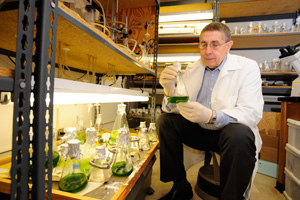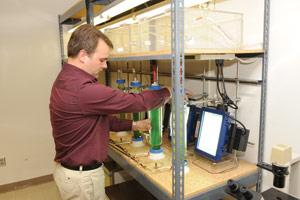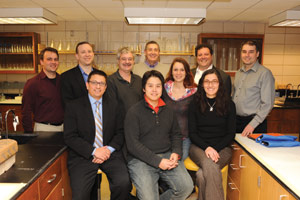Engineering the Perfect Algae Strain




April 26, 2010
BY Nicholas Zeman
When a series of labs collects data concerning different systems of the human body, they produce a reservoir of information known as metadata-which could be RNA and DNA knowledge of hela cells, nerve samples, or different aspects of the heart-often recorded using standardized methods. Researchers can use sophisticated computers to determine which clusters of experiments might be of use to each other.
"It's a great time to be a scientist," says Eve Wurtele, professor of genetics, development and cell biology at Iowa State University in Ames, Iowa. "We are able to gather massive amounts of data very quickly," she says. "My job in this project is to analyze the data that is gathered here at Iowa State and at other laboratories using computational analysis and bioinformatics. We can know every experiment computationally, and similarly, the variables involved."
The project to which Wurtele refers is an ISU effort underway investigating the process of genetically stacking traits in algae for biofuels production. With a $4.37 million grant from the U.S. DOE, ISU genetics professor and project lead Martin Spalding intends to develop a micro-algal platform allowing algae to be treated as a crop. The best analogy to this is stacking traits in corn. "Farmers could plant simple unmanipulated lines of corn that have high yield," Spalding says, "but you wouldn't get the drought tolerance you want. You could plant drought-tolerant corn, but you wouldn't get standability. But by genetically manipulating corn, you get all the traits you need."
Basil Nicolau, professor of biochemistry and an associate scientist at DOE's Ames Laboratory, says, "The biodiesel industry has developed out of seed crushing because seeds are dry. Algae, however, is relatively wet and that has been a main problem in terms of the percentages and yields of particular cultures."
One way to make algae grow faster is to adapt it to grow at higher temperatures. "Thermodynamically, if you increase the temperature you can accelerate the reaction that promotes growth," Nicolau says. "Most algae grow at around 20 degrees centigrade."
Scientific equipment is available to scan millions of cells often grown on agar plates and dyed with a special ink. In addition, these powerful robotic eyes can see what mutated cells can survive the pressure of elevated temperatures. Seeing the gene that allows for survival in the heat could precipitate the genetic development of an algal strain grown in conditions that cause it to produce more lipids at a faster rate. "Natural mutagenesis occurs all the time, and most natural mutations are detrimental," Spalding says. "But using the power of huge numbers-seeing literally millions of cells-we can see what is beneficial."
There is a lot of genetic/genomic information and prior science surrounding Chlamydomonas. "It's just been sequenced and it has a good genetic system," Nicolau tells Biodiesel Magazine. "Our job will be to introduce new genetic elements, and specifically, my role is to maximize the metabolic process by which the organism produces oil through biochemical etymology."
Metabolism, Biosynthesis and Gene Expression
Three terms that the ISU scientists often uttered in conjunction, or connection, with each other is metabolism, biosynthesis and gene expression. One process of metabolism is exemplified when algae take in carbon dioxide and produce a carbohydrate. Biosynthesis, in turn, concerns the metabolic pathway in which proteins carry out certain steps in the digestion process. It is in the examination of these proteins that the roles of bioinformatics and computational analysis enter.
A primary interest is how photosynthetic cells monitor their carbon status and regulate the genes involved in carbon assimilation in response to carbon availability. This is an example of metabolic regulation of gene expression, where products of metabolism act as signals in the regulation of gene expression. "We can perform very rapid, deep sequencing of the genes that are used to make proteins," Spalding says. "And we can compare the results with other experiments. There are a lot of experiments that track the expression of genes."
In Chlamydomonas, ISU is dissecting both the signal transduction pathway for adaptation to changes in CO2 and the microalgal "carbon concentrating mechanism" using insertional mutagenesis to generate tagged mutants subsequently relied upon to clone the key genes in the pathway. Identification of a key gene in the Chlamydomonas signal transduction pathway, cia5, has provided the opportunity to identify genes/proteins that interact with it using both suppressor analysis and the yeast two-hybrid system.
Of course, what Spalding and his team hope to accomplish is to increase the amount of lipid produced and the rate at which the algae produces it. When researchers dye the cells they can see "tiny droplets of oil." It is here that a stain accumulates and causes a light scanner to "fluoresce" as it passes through the cells. "So we can pick out the cells with high fluorescents," Spalding says. "It would be impossible to deal with any other way."
This process of selection and isolation is the backbone of genetic engineering. The proverbial "needle in the haystack" are those genes that are involved in the biosynthesis of lipids. So, the relentless search for those candidates present in the biosynthetic pathway that could lead to faster growth and increased fat production precedes the work involved with isolating mutants and modifying the genes. "Screening technology has opened up a whole world," Spalding says. "[Screening] a hundred million cells takes a couple of hours."
The Spalding Lab
The problem according to ISU is that no one really understands the genomes of most algae well enough to consider the possibility of stacking traits to make them produce more oil, offer better thermal resistance or any of the other characteristics needed. Currently, the algae used for biofuel development are wild strains found in nature that have certain traits growers like. "Using those algae is a good strategy, but the limitation with that strategy is that it has no flexibility because the algae can't be manipulated genetically," Spalding says.
Spalding's research in the lab focuses on regulation of carbon metabolism and carbon partitioning in plants and other photosynthetic organisms. "A primary interest is how photosynthetic cells monitor their carbon status and regulate genes involved in carbon assimilation in response to carbon availability," Spalding says. "This is an example of metabolic regulation of gene expression, where products of metabolism act as signals in the regulation of gene expression."
Ultimately, researchers believe the three-year study will produce many desirable traits in Chlamydomonas alga. "Our project will probably lead to increased production of basically vegetable oil that can be converted to biodiesel," Spalding says. "Using the same process we are using to increase that oil production, we also could divert the production into hydrocarbons, which are closer to petroleum." The end result could have several benefits. "It will mean we will have a more sustainable source [of energy] than we have now-more sustainable and more flexible," he says.
In other projects related more with traditional agriculture, ISU researchers are investigating the factors controlling partitioning of carbon metabolites in developing soybean embryos. These projects utilize isogenic soybean lines that differ markedly in their oil and protein contents, and represent part of a large effort at ISU to investigate the factors controlling carbon and nitrogen partitioning into oil versus protein.
Involvement of the Spalding lab includes analysis of changes in the proteome early in the development of soybean embryos in the isogenic lines, and application of a novel metabolic flux mapping technique, Metabolic Flux Ratio Analysis, to provide information about how the carbon flux changes through key steps in intermediary metabolism in developing soybean embryos across time, space or genotype.
Nicholas Zeman is associate editor of Biodiesel Magazine. Reach him at (701) 738-4972 or nzeman@bbiinternational.com.
"It's a great time to be a scientist," says Eve Wurtele, professor of genetics, development and cell biology at Iowa State University in Ames, Iowa. "We are able to gather massive amounts of data very quickly," she says. "My job in this project is to analyze the data that is gathered here at Iowa State and at other laboratories using computational analysis and bioinformatics. We can know every experiment computationally, and similarly, the variables involved."
The project to which Wurtele refers is an ISU effort underway investigating the process of genetically stacking traits in algae for biofuels production. With a $4.37 million grant from the U.S. DOE, ISU genetics professor and project lead Martin Spalding intends to develop a micro-algal platform allowing algae to be treated as a crop. The best analogy to this is stacking traits in corn. "Farmers could plant simple unmanipulated lines of corn that have high yield," Spalding says, "but you wouldn't get the drought tolerance you want. You could plant drought-tolerant corn, but you wouldn't get standability. But by genetically manipulating corn, you get all the traits you need."
Basil Nicolau, professor of biochemistry and an associate scientist at DOE's Ames Laboratory, says, "The biodiesel industry has developed out of seed crushing because seeds are dry. Algae, however, is relatively wet and that has been a main problem in terms of the percentages and yields of particular cultures."
One way to make algae grow faster is to adapt it to grow at higher temperatures. "Thermodynamically, if you increase the temperature you can accelerate the reaction that promotes growth," Nicolau says. "Most algae grow at around 20 degrees centigrade."
Scientific equipment is available to scan millions of cells often grown on agar plates and dyed with a special ink. In addition, these powerful robotic eyes can see what mutated cells can survive the pressure of elevated temperatures. Seeing the gene that allows for survival in the heat could precipitate the genetic development of an algal strain grown in conditions that cause it to produce more lipids at a faster rate. "Natural mutagenesis occurs all the time, and most natural mutations are detrimental," Spalding says. "But using the power of huge numbers-seeing literally millions of cells-we can see what is beneficial."
There is a lot of genetic/genomic information and prior science surrounding Chlamydomonas. "It's just been sequenced and it has a good genetic system," Nicolau tells Biodiesel Magazine. "Our job will be to introduce new genetic elements, and specifically, my role is to maximize the metabolic process by which the organism produces oil through biochemical etymology."
Metabolism, Biosynthesis and Gene Expression
Three terms that the ISU scientists often uttered in conjunction, or connection, with each other is metabolism, biosynthesis and gene expression. One process of metabolism is exemplified when algae take in carbon dioxide and produce a carbohydrate. Biosynthesis, in turn, concerns the metabolic pathway in which proteins carry out certain steps in the digestion process. It is in the examination of these proteins that the roles of bioinformatics and computational analysis enter.
A primary interest is how photosynthetic cells monitor their carbon status and regulate the genes involved in carbon assimilation in response to carbon availability. This is an example of metabolic regulation of gene expression, where products of metabolism act as signals in the regulation of gene expression. "We can perform very rapid, deep sequencing of the genes that are used to make proteins," Spalding says. "And we can compare the results with other experiments. There are a lot of experiments that track the expression of genes."
In Chlamydomonas, ISU is dissecting both the signal transduction pathway for adaptation to changes in CO2 and the microalgal "carbon concentrating mechanism" using insertional mutagenesis to generate tagged mutants subsequently relied upon to clone the key genes in the pathway. Identification of a key gene in the Chlamydomonas signal transduction pathway, cia5, has provided the opportunity to identify genes/proteins that interact with it using both suppressor analysis and the yeast two-hybrid system.
Of course, what Spalding and his team hope to accomplish is to increase the amount of lipid produced and the rate at which the algae produces it. When researchers dye the cells they can see "tiny droplets of oil." It is here that a stain accumulates and causes a light scanner to "fluoresce" as it passes through the cells. "So we can pick out the cells with high fluorescents," Spalding says. "It would be impossible to deal with any other way."
This process of selection and isolation is the backbone of genetic engineering. The proverbial "needle in the haystack" are those genes that are involved in the biosynthesis of lipids. So, the relentless search for those candidates present in the biosynthetic pathway that could lead to faster growth and increased fat production precedes the work involved with isolating mutants and modifying the genes. "Screening technology has opened up a whole world," Spalding says. "[Screening] a hundred million cells takes a couple of hours."
The Spalding Lab
The problem according to ISU is that no one really understands the genomes of most algae well enough to consider the possibility of stacking traits to make them produce more oil, offer better thermal resistance or any of the other characteristics needed. Currently, the algae used for biofuel development are wild strains found in nature that have certain traits growers like. "Using those algae is a good strategy, but the limitation with that strategy is that it has no flexibility because the algae can't be manipulated genetically," Spalding says.
Spalding's research in the lab focuses on regulation of carbon metabolism and carbon partitioning in plants and other photosynthetic organisms. "A primary interest is how photosynthetic cells monitor their carbon status and regulate genes involved in carbon assimilation in response to carbon availability," Spalding says. "This is an example of metabolic regulation of gene expression, where products of metabolism act as signals in the regulation of gene expression."
Ultimately, researchers believe the three-year study will produce many desirable traits in Chlamydomonas alga. "Our project will probably lead to increased production of basically vegetable oil that can be converted to biodiesel," Spalding says. "Using the same process we are using to increase that oil production, we also could divert the production into hydrocarbons, which are closer to petroleum." The end result could have several benefits. "It will mean we will have a more sustainable source [of energy] than we have now-more sustainable and more flexible," he says.
In other projects related more with traditional agriculture, ISU researchers are investigating the factors controlling partitioning of carbon metabolites in developing soybean embryos. These projects utilize isogenic soybean lines that differ markedly in their oil and protein contents, and represent part of a large effort at ISU to investigate the factors controlling carbon and nitrogen partitioning into oil versus protein.
Involvement of the Spalding lab includes analysis of changes in the proteome early in the development of soybean embryos in the isogenic lines, and application of a novel metabolic flux mapping technique, Metabolic Flux Ratio Analysis, to provide information about how the carbon flux changes through key steps in intermediary metabolism in developing soybean embryos across time, space or genotype.
Nicholas Zeman is associate editor of Biodiesel Magazine. Reach him at (701) 738-4972 or nzeman@bbiinternational.com.
Advertisement
Advertisement
Upcoming Events





